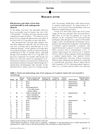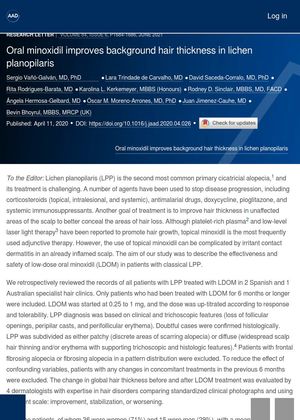TLDR Oral minoxidil can increase or maintain hair thickness in most people with lichen planopilaris, with mild side effects.
The retrospective study "Oral minoxidil improves background hair thickness in lichen planopilaris" involved 51 patients (36 women and 15 men) with an average age of 55, who were treated with low-dose oral minoxidil (LDOM) for at least 6 months. The results indicated that hair thickness improved in 39% of the patients, remained stable in 53%, and worsened in 8%. Patients with diffuse LPP responded better to the treatment than those with patchy LPP. Mild side effects were observed in 37% of the patients, including hypertrichosis, postural hypotension, tachycardia, and weight gain. The study concluded that LDOM can maintain or increase hair thickness in most LPP patients, with a tolerable safety profile.
35 citations
,
November 2019 in “Journal of the American Academy of Dermatology” A new variant of lichen planopilaris causing diffuse hair thinning was identified.
 52 citations
,
May 2019 in “Journal of The American Academy of Dermatology”
52 citations
,
May 2019 in “Journal of The American Academy of Dermatology” Low-dose oral minoxidil effectively improves male hair loss with mild side effects.
 56 citations
,
January 2019 in “Skin appendage disorders”
56 citations
,
January 2019 in “Skin appendage disorders” The most common hair loss type at specialist clinics is androgenetic alopecia, especially in younger men, followed by alopecia areata and telogen effluvium, with differences seen across regions.
 16 citations
,
December 2017 in “Journal of The American Academy of Dermatology”
16 citations
,
December 2017 in “Journal of The American Academy of Dermatology” Low-level laser therapy may reduce symptoms and increase hair thickness in lichen planopilaris patients.
January 2014 in “DOAJ (DOAJ: Directory of Open Access Journals)” Minoxidil can effectively treat patchy hair loss by stimulating hair growth.
4 citations
,
March 1991 in “Dermatitis” Minoxidil can cause skin reactions, so testing is important for those with side effects.
April 1985 in “Plastic & Reconstructive Surgery” Topical minoxidil can help regrow hair in alopecia areata but is less effective for severe cases.
 16 citations
,
April 1984 in “Archives of Dermatology”
16 citations
,
April 1984 in “Archives of Dermatology” Topical minoxidil can help hair regrowth in alopecia areata patients, but maintaining the growth after stopping treatment is inconsistent.




